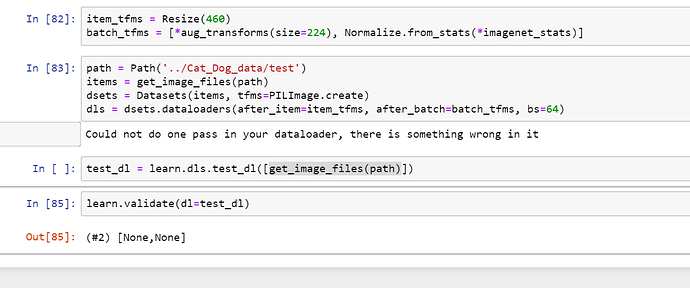So let’s walk through predict, specifically where it calls get_preds:
inp,preds,_,dec_preds = self.get_preds(dl=dl, with_input=True, with_decoded=True)
We see here we get back our input passed in, and with_decoded. This decoded is for the loss function only. decode_batch then decodes from our DataBlock.
For a different way to look at it, take my fastinference library I’ve been building. I rebuilt the get_preds function to make it a bit more efficient, but for all intensive purposes it still acts and behaves the same way the framework does:
for batch in dl:
with torch.no_grad():
...
if decoded_loss or fully_decoded:
out = x.model(*batch[:x.dls.n_inp])
raw.append(out)
dec_out.append(x.loss_func.decodes(out))
else:
raw.append(x.model(*batch[:x.dls.n_inp]))
This is how I get predictions (this is all hidden inside get_preds and the GatherPreds callback, so it’s hard to figure out. Presume it’s this with a bit more abstractness)
So we can see that if I want to decode my loss, I decode via the loss_func. At the end I’ll go through and get a result similar to predict here:
if not raw_outs:
try: outs.insert(0, x.loss_func.activation(tensor(raw)).numpy())
except: outs.insert(0, dec_out)
else:
outs.insert(0, raw)
if fully_decoded: outs = _fully_decode(x.dls, inps, outs, dec_out, is_multi)
if decoded_loss: outs = _decode_loss(x.dls.vocab, dec_out, outs)
return outs
(And I’m going to do a video walkthrough of this whole thing this weekend too, that may help some.)
That’s a long explanation but does this help? To see _fully_decode and _decode_loss, see here, I’m going to go through those in the video, just a lot to explain here  (but it’s good to keep in mind because the fastai framework operates in this same way!)
(but it’s good to keep in mind because the fastai framework operates in this same way!)
Also, my version has an option return a fully decoded output similar to learn.predict, that’s why it will look different.

 Are you having any more videos sessions? Any fastai related study group link. I was quite busy over the past month (job change) but I would like to get fully back to it!!
Are you having any more videos sessions? Any fastai related study group link. I was quite busy over the past month (job change) but I would like to get fully back to it!! I just need to find a better way not to miss out on them!
I just need to find a better way not to miss out on them!



 where does the with_label goes?
where does the with_label goes?